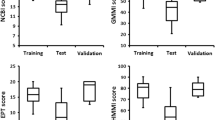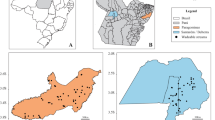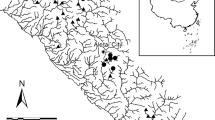Abstract
Family-level biotic metrics were originally designed to rapidly assess gross organic pollution effects, but came to be regarded as general measures of stream degradation. Improvements in water quality in developed countries have reignited debate about the limitations of family-level taxonomy to detect subtle change, and is resulting in a shift back towards generic and species-level analysis to assess smaller effects. Although the scale of pollution characterizing past condition of streams in developed countries persists in many developing regions, some areas are still considered to be only moderately disturbed. We sampled streams in Belize to investigate the ability of family-level macroinvertebrate metrics to detect change in stream catchments where less than 30% of forest had been cleared. Where disturbance did not co-vary with natural gradients of change, and in areas characterized by low intensity activities, none of the metrics tested detected significant change, despite evidence of environmental impacts. We highlight the need for further research to clarify the response of metrics to disturbance over a broader study area that allows replication for confounding sources of natural variation. We also recommend research to develop more detailed understanding of the taxonomy and ecology of Neotropical macroinvertebrates to improve the robustness of metric use.




Similar content being viewed by others
References
Alonso-EguíaLis, P., J. M. Mora, B. Campbell & M. Springer (eds), 2014. Diversidad, conservación y uso de los macroinvertebrados dulceacuícolas de México, Centroamérica, Colombia, Cuba y Puerto Rico. Instituto Mexicano de Tecnología del Agua, Jiutepec, México, 444 pp.
Anderson, M. J., R. N. Gorley & K. R. Clarke, 2008. PERMANOVA+ for PRIMER: guide to software and statistical methods. PRIMER-E Ltd., Plymouth.
AQEM Consortium, 2002. Manual for the application of the AQEM method. A comprehensive method to assess European streams using benthic macroinvertebrates, developed for the purpose of the Water Framework Directive. Version 1.0. http://www.aqem.de/mains/products.php. Accessed 24th July 2013.
Armitage, P. D., D. Moss, J. F. Wright & M. T. Furse, 1983. The performance of a new biological water quality score system based on macroinvertebrates over a wide range of unpolluted running-water sites. Water Research 17: 333–347.
Benstead, J. P., M. M. Douglas & C. M. Pringle, 2003. Relationships of stream invertebrate communities to deforestation in eastern Madagascar. Ecological Applications 13: 1473–1490.
Bojsen, B. H. & D. Jacobsen, 2003. Effects of deforestation on macroinvertebrate diversity and assemblage structure in Ecuadorian Amazon streams. Archiv Fur Hydrobiologie 158: 317–342.
Boonsoong, B., N. Sangpradub & M. T. Barbour, 2009. Development of rapid bioassessment approaches using benthic macroinvertebrates for Thai streams. Environmental Monitoring and Assessment 155: 129–147.
Bray, J. R. & J. T. Curtis, 1957. An ordination of the upland forest communities of southern Wisconsin. Ecological Monographs 27: 325–349.
Brown, B. V., A. Borkent, J. M. Cumming, D. M. Wood, N. E. Woodley & M. A. Zumbado, 2009. Manual of Central American Diptera. Volume 1, vol 1. NRC Research Press, Ottawa.
Buendia, C., C. N. Gibbins, D. Vericat, R. J. Batalla & A. Douglas, 2013. Detecting the structural and functional impacts of fine sediment on stream invertebrates. Ecological Indicators 25: 184–196.
Buss, D. F. & F. F. Salles, 2007. Using Baetidae species as biological indicators of environmental degradation in a Brazilian river basin. Environmental Monitoring and Assessment 130: 365–372.
Buss, D. F. & A. S. Vitorino, 2010. Rapid bioassessment protocols using benthic macroinvertebrates in Brazil: evaluation of taxonomic sufficiency. Journal of the North American Benthological Society 29: 562–571.
Capps, K. A., C. N. Bentsen & A. Ramírez, 2016. Poverty, urbanization, and environmental degradation: urban streams in the developing world. Freshwater Science 35: 429–435.
Carrie, R. H. & E. Kay, 2014. Belize. In Alonso-EguíaLis, P., J. M. Mora, B. Campbell & M. Springer (eds), Diversidad, conservación y uso de los macroinvertebrados dulceacuícolas de México, Centroamérica, Colombia, Cuba y Puerto Rico. Instituto Mexicano de Tecnología del Agua, Jiutepec: 33–62.
Carrie, R. H., M. Dobson & J. Barlow, 2015. Effects of geology and season on macroinvertebrates in lowland Belizean streams: implications for tropical bio-assessment. Freshwater Sciences 4: 648–662.
Castillo, L. E., E. Martinez, C. Ruepert, C. Savage, M. Gilek, M. Pinnock & E. Solis, 2006. Water quality and macroinvertebrate community response following pesticide applications in a banana plantation, Limon, Costa Rica. Science of the Total Environment 367: 418–432.
Chang, F., J. E. Lawrence, B. Rios-Touma & V. H. Resh, 2014. Tolerance values of benthic macroinvertebrates for stream biomonitoring: assessment of assumptions underlying scoring systems worldwide. Environmental monitoring and assessment 186: 2135–2149.
Cherrington, E. A., E. Ek, P. Cho, B. F. Howell, B. E. Hernandez, E. R. Anderson, A. I. Flores, B. C. Garcia, A. Sempris & D. E. Irwin, 2010. Forest Cover and Deforestation in Belize: 1980–2010. Water Center for the Humid Tropics of Latin America and the Caribbean (Cathalac), Panama, Panama City.
Clarke, K. R. & R. N. Gorley, 2006. PRIMER v6: User Manual/Tutorial. PRIMER-E Ltd, Plymouth.
Clarke, K. R. & R. M. Warwick, 2001. Change in Marine Communities: An Approach to Statistical Analysis and Interpretation, 2nd ed. Plymouth Marine Laboratory, Plymouth.
Cohen, B., 2006. Urbanization in developing countries: current trends, future projections, and key challenges for sustainability. Technology in Society 28: 63–80.
Connolly, N. M., M. R. Crossland & R. G. Pearson, 2004. Effect of low dissolved oxygen on survival, emergence, and drift of tropical stream macroinvertebrates. Journal of the North American Benthological Society 23: 251–270.
Development Core Team, R., 2008. R: A Language and Environment for Statistical Computing. R Foundation for Statistical Computing, Vienna.
Dickens, C. W. S. & P. M. Graham, 2002. The South African Scoring System (SASS) version 5 rapid bioassessment method for rivers. African Journal of Aquatic Science 27: 1–10.
Dobson, M., A. Magana, J. M. Mathooko & F. K. Ndegwa, 2002. Detritivores in Kenyan highland streams: more evidence for the paucity of shredders in the tropics? Freshwater Biology 47: 909–919.
Dolédec, S., J. Olivier & B. Statzner, 2000. Accurate description of the abundance of taxa and their biological traits in stream invertebrate communities: effects of taxonomic and spatial resolution. Archiv Fur Hydrobiologie 148: 25–43.
Dudgeon, D., 2012. Responses of benthic macroinvertebrate communities to altitude and geology in tributaries of the Sepik River (Papua New Guinea): the influence of taxonomic resolution on the detection of environmental gradients. Freshwater Biology 57: 1794–1812.
Dufrêne, M. & P. Legendre, 1997. Species assemblages and indicator species: the need for a flexible asymmetrical approach. Ecological Monographs 67: 345–366.
Esselman, P. C., 2001. An Ecological Baseline Study of Physical Habitat, Water Chemistry and Fish Assemblages of the Monkey River Watershed, Belize. MSc. thesis, University of Georgia.
Friberg, N., N. Bonada, D. C. Bradley, M. J. Dunbar, F. K. Edwards, J. Grey, R. B. Hayes, A. G. Hildrew, N. Lamouroux, M. Trimmer & G. Woodward, 2011. Biomonitoring of human impacts in freshwater ecosystems: the good, the bad and the ugly. In Woodward, G. (ed.), Ecosystems in a Human-Modified Landscape: A European Perspective: 44 (Advances in Ecological Research). Academic Press, London: 1–68.
Hajibabaei, M., S. Shokralla, X. Zhou, G. A. C. Singer & D. J. Baird, 2011. Environmental barcoding: a next-generation sequencing approach for biomonitoring applications using river benthos. PLoS ONE 6: e17497.
Harding, J., J. M. Quinn & C. W. Hickey, 2000. Effects of mining and production forestry. In Collier, K. J. & M. J. Winterbourn (eds), New Zealand Stream Invertebrates: Ecology and Implications for Management. New Zealand Limnological Society, Christchurch: 230–259.
Hawkins, C. P., R. H. Norris, J. N. Hogue & J. W. Feminella, 2000. Development and evaluation of predictive models for measuring the biological integrity of streams. Ecological Applications 10: 1456–1477.
Heino, J., 2014. Taxonomic surrogacy, numerical resolution and responses of stream macroinvertebrate communities to ecological gradients: are the inferences transferable among regions? Ecological Indicators 36: 186–194.
Helson, J. E. & D. D. Williams, 2013. Development of a macroinvertebrate multimetric index for the assessment of low-land streams in the neotropics. Ecological Indicators 29: 167–178.
Hilsenhoff, W. L., 1988. Rapid field assessment of organic pollution with a family-level biotic index. Journal of the North American Benthological Society 7: 65–68.
Jacobsen, D., 1998. The effect of organic pollution on the macroinvertebrate fauna of Ecuadorian highland streams. Archiv Fur Hydrobiologie 143: 179–195.
Jacobsen, D., C. Cressa, J. M. Mathooko & D. Dudgeon, 2008. Macroinvertebrates: composition, life histories and production. In Dudgeon, D. (ed.), Tropical Stream Ecology. Elsevier Academic Press, London: 66–96.
Jones, F. C., 2008. Taxonomic sufficiency: the influence of taxonomic resolution on freshwater bioassessments using benthic macroinvertebrates. Environmental Reviews 16: 45–69.
Kaufmann, P. R., P. Levine, E. G. Robison, C. Seeliger & D. V. Peck, 1999. Quantifying Physical Habitat in Wadeable Streams. Environmental Protection Agency, Washington, D.C.: 102.
Knee, K. L. & A. C. Encalada, 2013. Land Use and Water Quality in a Rural Cloud Forest Region (Intag, Ecuador). River Research and Applications 30: 385–401.
Kobingi, N., P. O. Raburu, F. O. Masese & J. Gichuki, 2009. Assessment of pollution impacts on the ecological integrity of the Kisian and Kisat rivers in Lake Victoria drainage basin, Kenya. African Journal of Environmental Science and Technology 3: 097–107.
Kolkwitz, R. & M. Marsson, 1909. Ökologie der tierischen Saprobien. Beiträge zur Lehre von der biologischen Gewässerbeurteilung. Internationale Revue der gesamten Hydrobiologie und Hydrographie 2: 126–152.
Kratzer, E. B., J. K. Jackson, D. B. Arscott, A. K. Aufdenkampe, C. L. Dow, L. A. Kaplan, J. D. Newbold & B. W. Sweeney, 2006. Macroinvertebrate distribution in relation to land use and water chemistry in New York City drinking-water-supply watersheds. Journal of the North American Benthological Society 25: 954–976.
Lenat, D. R. & V. H. Resh, 2001. Taxonomy and stream ecology. The benefits of genus and species level identifications. Journal of the North American Benthological Society 20: 287–298.
Lewis, W. M. J., 2008. Physical and chemical features of tropical flowing waters. In Dudgeon, D. (ed.), Tropical Stream Ecology. Academic Press, USA: 1–22.
Ligeiro, R., R. M. Hughes, P. R. Kaufmann, D. R. Macedo, K. R. Firmiano, W. R. Ferreira, D. Oliveira, A. S. Melo & M. Callisto, 2013. Defining quantitative stream disturbance gradients and the additive role of habitat variation to explain macroinvertebrate taxa richness. Ecological Indicators 25: 45–57.
Lorion, C. M. & B. P. Kennedy, 2009. Relationships between deforestation, riparian forest buffers and benthic macroinvertebrates in neotropical headwater streams. Freshwater Biology 54: 165–180.
Merritt, R. W., K. W. Cummins & M. B. Berg, 2008. An Introduction to the Aquatic Insects of North America, 4th ed. Kendall Hunt Publishing Company, Iowa.
Metzeling, L., S. Perriss & D. Robinson, 2006. Can the detection of salinity and habitat simplification gradients using rapid bioassessment of benthic invertebrates be improved through finer taxonomic resolution or alternative indices? Hydrobiologia 572: 235–252.
Monk, W. A., P. J. Wood, D. M. Hannah, C. A. Extence, R. P. Chadd & M. J. Dunbar, 2012. How does macroinvertebrate taxonomic resolution influence ecohydrological relationships in riverine ecosystems. Ecohydrology 5: 36–45.
Moya, N., R. M. Hughes, E. Domínguez, F.-M. Gibon, E. Goitia & T. Oberdorff, 2011. Macroinvertebrate-based multimetric predictive models for evaluating the human impact on biotic condition of Bolivian streams. Ecological Indicators 11: 840–847.
Mugnai, R., J. L. Nessimian & D. F. Baptista, 2010. Manual de Identificacao de Macroinvertebrados Aquaticos. Technical Books Editora, Rio de Janeiro.
Murphy, J. F., J. Davy-Bowker, B. McFarland & S. J. Ormerod, 2013. A diagnostic biotic index for assessing acidity in sensitive streams in Britain. Ecological Indicators 24: 562–572.
Naranjo López, C., D. D. González Lazo, A. L. Blandimarte, S. Munoz Riveaux & Y. Musle Cordero, 2005. Una metodología rápida y de fácil aplicación para la evaluación de la calidad del agua utilizando el índice BMWP-Cub para ríos cubanos. Revista Tecnura 9: 65–76.
Natural Resources Conservation Service, 1998. Stream Visual Assessment Protocol, Washington, DC.
Neff, M. R. & D. A. Jackson, 2011. Effects of broad-scale geological changes on patterns in macroinvertebrate assemblages. Journal of the North American Benthological Society 30: 459–473.
Odum, E. P., J. T. Finn & E. H. Franz, 1979. Perturbation theory and the subsidy-stress gradient. Bioscience 29: 349–352.
Peck, D. V., A. T. Herlihy, B. H. Hill, R. M. Hughes, P. R. Kauffman, D. J. Klemm, J. M. Lazorchak, F. H. McCormick, S. A. Peterson, P. L. Ringold, T. Magee & M. Cappaert, 2006. Environmental Monitoring and Assessment Program-Surface Waters Western Pilot Study: Field Operations Manual for Wadeable Streams. Washington, DC, U.S. Environmental Protection Agency.
Poquet, J. M., J. Alba-Tercedor, T. Punti, M. D. Sanchez-Montoya, S. Robles, M. Alvarez, C. Zamora-Munoz, C. E. Sainz-Cantero, M. R. Vidal-Abarca, M. L. Suarez, M. Toro, A. M. Pujante, M. Rieradevall & N. Prat, 2009. The MEDiterranean Prediction And Classification System (MEDPACS): an implementation of the RIVPACS/AUSRIVAS predictive approach for assessing Mediterranean aquatic macroinvertebrate communities. Hydrobiologia 623: 153–171.
Raburu, P. O., J. B. Okeyo-Owuor & F. O. Masese, 2009. Macroinvertebrate-based Index of biotic integrity (M-IBI) for monitoring the Nyando River, Lake Victoria Basin, Kenya. Scientific Research and Essays 4: 1468–1477.
Resh, V. H., 2007. Multinational, freshwater biomonitoring programs in the developing world: lessons learned from African and Southeast Asian river surveys. Environmental Management 39: 737–748.
Richards, C., R. Haro, L. Johnson & G. Host, 1997. Catchment and reach-scale properties as indicators of macroinvertebrate species traits. Freshwater Biology 37: 219–230.
Ríos-Touma, B., R. Acosta & N. Prat, 2014. The Andean Biotic Index (ABI): revised tolerance to pollution values for macroinvertebrate families and index performance evaluation. Revista de Biología Tropical 62: 249–273.
Roque, F. O., L. S. Lecci, T. Siqueira & C. G. Froehlich, 2008. Using environmental and spatial filters to explain stonefly occurrences in southeastern Brazilian streams: implications for biomonitoring. Acta Limnologica Brasiliensia 20: 35–44.
Schäfer, R. B., T. Caquetc, K. Siimesd, R. Muellere, L. Lagadicc & M. Liessa, 2007. Effects of pesticides on community structure and ecosystem functions in agricultural streams of three biogeographical regions in Europe. Science of the Total Environment 382: 272–285.
Smith, M. J., W. R. Kay, D. H. D. Edward, P. J. Papas, K. S. J. Richardson, J. C. Simpson, A. M. Pinder, D. J. Cale, P. H. J. Horwitz, J. A. Davis, F. H. Yung, R. H. Norris & S. A. Halse, 1999. AusRivAS: using macroinvertebrates to assess ecological condition of rivers in Western Australia. Freshwater Biology 41: 269–282.
Springer, M., A. Ramirez & P. Hanson, 2010. Macroinvertebrados de Agua Dulce de Costa Rica I, Vol. 58 (Supl. 4). Revista de Biologia Tropical, San Jose, Costa Rica.
Statistical Institute of Belize, 2016. Population estimates by Major Administrative Areas and Sex, 2008–2016. http://www.sib.org.bz/statistics/population. Accessed 08 November 2016.
Stein, E. D., B. P. White, R. D. Mazor, J. K. Jackson, J. M. Battle, P. E. Miller, E. M. Pilgrim & B. W. Sweeney, 2014. Does DNA barcoding improve performance of traditional stream bioassessment metrics? Freshwater Science 33: 302–311.
Sutherland, A. B., J. M. Culp & G. A. Benoy, 2012. Evaluation of deposited sediment and macroinvertebrate metrics used to quantify biological response to excessive sedimentation in agricultural streams. Environmental Management 50: 50–63.
Taylor, B. R., 1997. Rapid assessment procedures: radical re-invention or just sloppy science? Human and Ecological Risk Assessment: An International Journal 3: 1005–1016.
Thorne, R. S. & W. P. Williams, 1997. The response of benthic macroinvertebrates to pollution in developing countries: a multimetric system of bioassessment. Freshwater Biology 37: 671–686.
Tomanova, S. & P. A. Tedesco, 2007. Body size, ecological tolerance and potential for water quality bioindication in the genus Anacroneuria (Plecoptera: Perlidae) from South America. Revista De Biologia Tropical 55: 67–81.
Tomanova, S. & P. Usseglio-Polatera, 2007. Patterns of benthic community traits in neotropical streams: relationship to mesoscale spatial variability. Fundamental and Applied Limnology 170: 243–255.
Tomanova, S., N. Moya & T. Oberdorff, 2008. Using macroinvertebrate biological traits for assessing biotic integrity of neotropical streams. River Research and Applications 24: 1230–1239.
Waite, I. R., A. T. Herlihy, D. P. Larsen, N. S. Urquhart & D. J. Klemm, 2004. The effects of macroinvertebrate taxonomic resolution in large landscape bioassessments: an example from the Mid-Atlantic Highlands, USA. Freshwater Biology 49: 474–489.
Woodiwiss, F. S., 1964. The biological system of stream classification used by the River Trent Board. Chemistry and Industry 14: 443–447.
Wright, J. F., 2000. An Introduction to RIVPACS. Freshwater Biological Association, Ambleside.
WWAP (United Nations World Water Assessment Programme), 2015. The United Nations World Water Development Report 2015: Water for a Sustainable World. UNESCO, Paris.
Wyżga, B., P. Oglęcki, H. Hajdukiewicz, J. Zawiejska, A. Radecki-Pawlik, T. Skalski & P. Mikuś, 2013. Interpretation of the invertebrate-based BMWP-PL index in a gravel-bed river: insight from the Polish Carpathians. Hydrobiologia 712: 71–88.
Yates, A. & R. Bailey, 2010. Covarying patterns of macroinvertebrate and fish assemblages along natural and human activity gradients: implications for bioassessment. Hydrobiologia 637: 87–100.
Zuur, A., E. N. Ieno, N. Walker, A. A. Saveliev & G. M. Smith, 2009. Mixed effects models and extensions in ecology with R. Springer, New York.
Acknowledgements
This research was funded by the Natural Environmental Research Council-Economic Research Council grant ES/F013035/1, the Rufford Small Grants Foundation (Grant 11376-2), and the Freshwater Biological Association Hugh Cary Gilson Memorial Award for 2012, and made possible by the Ya’axché Conservation Trust, particularly Devina Bol, Anignazio Makin, Octavio Cal, Pastor Ayala and Abelino Zuniga who provided assistance in the field and laboratory. We also thank Nabor Moya for clarifying the fuzzy-coding technique, Patrick Keenan and Phil Haygarth for assistance with nutrient analysis, and John Murphy for comments on an earlier draft. We gratefully acknowledge the Belize Fisheries Department, Belize Forest Department and Belize Agricultural Health Authority for permitting the study and export of specimens and the Animal Health and Veterinary Laboratories Agency for permitting the import of specimens into the UK, and anonymous reviewers for their comments on earlier versions of this manuscript.
Author information
Authors and Affiliations
Corresponding author
Ethics declarations
Conflict of interest
None of the authors has conflict interests, financial or otherwise.
Additional information
Handling editor: Checo Colón-Gaud
Electronic supplementary material
Below is the link to the electronic supplementary material.
Rights and permissions
About this article
Cite this article
Carrie, R., Dobson, M. & Barlow, J. Challenges using extrapolated family-level macroinvertebrate metrics in moderately disturbed tropical streams: a case-study from Belize. Hydrobiologia 794, 257–271 (2017). https://doi.org/10.1007/s10750-017-3100-z
Received:
Revised:
Accepted:
Published:
Issue Date:
DOI: https://doi.org/10.1007/s10750-017-3100-z




